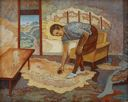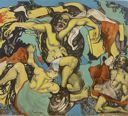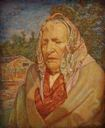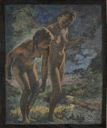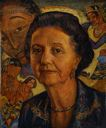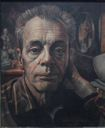William Jensen Parkinson does not have an image.
William Jensen Parkinson
(Hyrum, Utah, 1899 - 1993, Midvale, Utah)
William J. Parkinson was born February 14, 1899, in Hyrum, Utah. Parkinson remembers even his earliest interests in art. When he was a young boy, he began sketching people in the congregation to occupy himself during church. Throughout his life Parkinson enjoyed going to libraries and other public locations to sketch people. Parkinson's formal art training came as a student at LDS High School under the direction of A.B. Wright. He was looked upon by fellow students as Wright's top student and contributed numerous drawings to school newspapers and magazines. While in high school Parkinson began collecting art books. Those books became the major source for his self-taught artistic training. Parkinson enrolled at the University of Utah but chose not to study art at the university level. The only other formal training he received was a few correspondence courses taken later in life. Using his art books, Parkinson studied the great masters like Michelangelo and Rembrandt. He established his artistic abilities on solid artistic foundations and anatomical knowledge he gained in college studies. He believed a solid foundation was necessary before an artist could venture into more inventive realms. In 1934, Parkinson applied for a Federal Public Works grant to receive funds to support a three-to-six-month excursion to work in a National Park. Most artists participating in the program were sent to federal camps in scenic locations like Yellowstone National Park. The works produced during the excursion were to be given to the parks for their collections. Parkinson's request was granted and his assignment given. He was sent to "Old Boundary Springs" in California. It was a hospital for World War I veterans. Parkinson did not receive the scenic location he had expected, but while in California, he was prevailed upon by the veterans to produce private family portraits. He also did several landscapes of the surrounding hills, which still remain in the state collection. Upon his return from California, Parkinson found employment in several fields as well as receiving state commissions for murals, several of which were for McKinley School in Salt Lake City. Parkinson began to break away from tradition, working with movement and the relationship of planes. During the 1930s, the style of the "Dirty Thirties" began to make its way into Utah. Parkinson's almost surreal approach and unique use of color was considered modern in its overall concept. Later in his career, Parkinson moved into a more Fauvist and Cubist style, retaining his place as a leader in Utah art. Perhaps the works that best show Parkinson's solid artistic ability are those from a commission from Washington DC to contribute to the Index of American Design. He was to reproduce, in color, the needlework of pioneer women of Utah. In fine detail, Parkinson was able to recreate the needleworks, accurately conveying their downy and three-dimensional qualities. The Washington coordinator of the designs said the following concerning Parkinson's works: "I sat with amazement, I couldn't tell the difference between the real and the copy. Your works are the best in the exhibit." A combination of a solid traditional foundation and a progressive attitude led to numerous Surrealist and Cubist works that place Parkinson on the leading edge of Utah art during her transition from traditional to "modern art."
(Hyrum, Utah, 1899 - 1993, Midvale, Utah)
William J. Parkinson was born February 14, 1899, in Hyrum, Utah. Parkinson remembers even his earliest interests in art. When he was a young boy, he began sketching people in the congregation to occupy himself during church. Throughout his life Parkinson enjoyed going to libraries and other public locations to sketch people. Parkinson's formal art training came as a student at LDS High School under the direction of A.B. Wright. He was looked upon by fellow students as Wright's top student and contributed numerous drawings to school newspapers and magazines. While in high school Parkinson began collecting art books. Those books became the major source for his self-taught artistic training. Parkinson enrolled at the University of Utah but chose not to study art at the university level. The only other formal training he received was a few correspondence courses taken later in life. Using his art books, Parkinson studied the great masters like Michelangelo and Rembrandt. He established his artistic abilities on solid artistic foundations and anatomical knowledge he gained in college studies. He believed a solid foundation was necessary before an artist could venture into more inventive realms. In 1934, Parkinson applied for a Federal Public Works grant to receive funds to support a three-to-six-month excursion to work in a National Park. Most artists participating in the program were sent to federal camps in scenic locations like Yellowstone National Park. The works produced during the excursion were to be given to the parks for their collections. Parkinson's request was granted and his assignment given. He was sent to "Old Boundary Springs" in California. It was a hospital for World War I veterans. Parkinson did not receive the scenic location he had expected, but while in California, he was prevailed upon by the veterans to produce private family portraits. He also did several landscapes of the surrounding hills, which still remain in the state collection. Upon his return from California, Parkinson found employment in several fields as well as receiving state commissions for murals, several of which were for McKinley School in Salt Lake City. Parkinson began to break away from tradition, working with movement and the relationship of planes. During the 1930s, the style of the "Dirty Thirties" began to make its way into Utah. Parkinson's almost surreal approach and unique use of color was considered modern in its overall concept. Later in his career, Parkinson moved into a more Fauvist and Cubist style, retaining his place as a leader in Utah art. Perhaps the works that best show Parkinson's solid artistic ability are those from a commission from Washington DC to contribute to the Index of American Design. He was to reproduce, in color, the needlework of pioneer women of Utah. In fine detail, Parkinson was able to recreate the needleworks, accurately conveying their downy and three-dimensional qualities. The Washington coordinator of the designs said the following concerning Parkinson's works: "I sat with amazement, I couldn't tell the difference between the real and the copy. Your works are the best in the exhibit." A combination of a solid traditional foundation and a progressive attitude led to numerous Surrealist and Cubist works that place Parkinson on the leading edge of Utah art during her transition from traditional to "modern art."
Artist Objects
